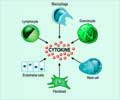Researchers at the University of Texas M.D. Anderson Cancer Center have found that the incidence of mantle cell lymphoma, a deadly form of non-Hodgkin's lymphoma, is on the rise.
Sadly, another deadly form of the killer disease has been discovered. Researchers at the University of Texas M.D. Anderson Cancer Center have found that the incidence of mantle cell lymphoma, a deadly form of non-Hodgkin's lymphoma, is on the rise. And this is lethal formis incurable.
Writing about their findings in the journal CANCER, the researchers have revealed that this disease is most frequently striking men, Caucasians and older individuals.The study has also revealed that most patients are diagnosed with advanced stages of the disease.
In their study report, the researchers say that the prevalence of mantle cell lymphoma has yet to be determined.
Mantle cell lymphoma, first established as a type of lymphoma in 1992, is a fast-growing cancer of the immune system, that is characterized by small- to medium-size cancer cells that may be in the lymph nodes, spleen, bone marrow, blood or gastrointestinal system.
Despite the availability of many different types of therapies, it remains incurable.
Dr. Michael Wang and his colleagues set out to determine how many people have been diagnosed with mantle cell lymphoma since it was first recognized, and examined cancer registry data from 1992 to 2004, the most recent year for which complete data are available.
Advertisement
Age was a significant risk factor, with people between the ages of 70 to 79 more likely to be diagnosed with mantle cell lymphoma than all other age groups.
Advertisement
Drs. Wang and Du observed that the incidence rates increased progressively over time.
In 1992, only 2.7 people per 1,000,000 were diagnosed, compared with 6.9 people per 1,000,000 in 2004.
The researchers said that they were clueless about the cause of the remarkable increase in the incidence rate of the disease over the past 13 years.
"A better understanding of the epidemiology of mantle cell lymphoma, the development of novel agents, more research funding and increased public awareness are all needed," the authors write.
Source-ANI
TAN/L














